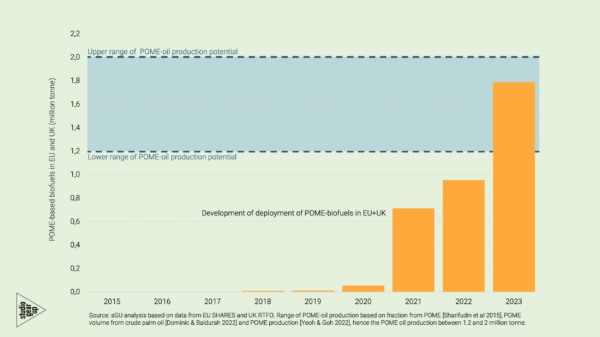With Delegated Regulation (EU) 2019/807 the European Commission defined several options to certify low ILUC-risk feedstock for EU biofuels. Now that the criteria have been worked out and tested, it becomes clear that the approaches are highly complex, while the additional yields will likely be small. If low ILUC-risk certification becomes the norm for all biofuels, climate action in transport would get another setback.
Background
Indirect Land Use Change (ILUC) can occur when land that originally had one function, is now used for a different function. Possibly, but depending on many complex mechanisms, the original function is displaced to other land, which could come at the cost of a carbon stock change.
The concept of ILUC was introduced following the food versus fuel debates in 2008. The main concern was that an increased demand for biofuels would indirectly lead to the creation of new agricultural land elsewhere. If that would be in high carbon land, such as tropical forests or peatland, the resulting greenhouse gas emissions could undo or even be larger than the savings achieved by biofuels replacing fossil fuels.
ILUC is a contentious but important topic in the biofuels policy debate. But, in principle, ILUC occurs from any change of land function: a meadow that is converted to a golf course, or agricultural land that is restored to nature.
Palm oil is currently the only crop identified to have high ILUC-risks
The first analyses around 2008 suggested that all crop-based biofuels would have high ILUC-risks. Later, more detailed analysis identified palm oil as the only crop with high ILUC-risks. This implies that a significant increase in the use of palm oil for biofuels could lead to high indirect emissions. Small increases of such biofuels from such crops, or maintaining the current level do not lead to indirect emissions.
Delegated Regulation (EU) 2019/807 provided a method to officially identify high ILUC-risk biofuels. With the data included in its annex, again palm oil is identified as a high ILUC-risk feedstock. We will dive into that analysis in one of our next blogs.
Low ILUC-risk certification was introduced to prevent high ILUC-risk
According to the Renewable Energy Directive (EU) 2018/2001, the contribution of biofuels that are produced from such high ILUC-risk feedstocks should be phased out by 2030. Since the identification depends on a global analysis, there are exceptions for individual cases. Therefore, crops that are generally identified as high ILUC-risk, can still be used in EU biofuels, but only in individual cases where it is proven that the crop has low ILUC-risks.
This means that if one would like to use palm oil for biofuels in the frame of the Renewable Energy Directive, then this palm oil would have to be certified as low ILUC-risk.
The Delegated Regulation (EU) 2019/807 sets out the options and criteria for low ILUC-risk feedstocks and their certification. The rules are complex as we will see below. The European Commission hired Guidehouse to operationalise the criteria, and to pilot the certification.
Recently, Guidehouse reported about the ILUC-risk pilots that they carried out in the recent years. Let’s have a look and find out what it means for low ILUC-risk certification.
Low ILUC-risk certification pilots covers mostly crops that already have a low ILUC-risk
The low ILUC-risk certification pilots were carried out in ten locations around the world. Four of these concerned palm oil in tropical plantation settings. The other pilots concern plots of land mainly in Europe with annual crops such as rapeseed, brassica carinata, camelina and soybean. This implies that the low ILUC-risk certification method is tested for crops that do not have a high ILUC-risk, and that do not need such certification within the current policy framework.
Options for low ILUC-risk certification are complex or have limited application
According to the Delegated Regulation, Low ILUC-risk feedstocks must be additional to what you would normally expect. The rules are very strict. The additional feedstock can only be certified low ILUC-risk if it is resulting from so-called “additionality measures”. And these additionality measures would not be implemented in normal market situations, but only as a result of a specific demand for such low-ILUC risk feedstocks.
The Regulation presents three main options:
- Production above the yield trendline within existing crop systems
- New cultivation of crops on abandoned or severely degraded land
- Production by smallholders
Production above the yield trendline
The first method is the most challenging. While it is already challenging to establish a trendline to predict what would have been the yield in absence of additionality measures, it is especially challenging to prove that a yield in a certain year is significantly above that trendline: Natural variation should be considered, which gives the trendline a wide significance interval. This then implies that a higher yield could have been caused by favourable weather. So, the yield needs should not only be higher than the trendline, but also higher than the significance interval, in order to count as low ILUC-risk. Weather impacts can also decrease the yields – which further reduces the occurrence of yields above the trendlines. Guidehouse observes that in some situations, the impact of weather is larger than the impact of additionality measures: “yield variations caused by external effects like weather are hard to disentangle from the impact of additionality measures. This makes it hard to truly claim that the additional biomass represents the “real” increase compared to business as usual caused by the additionality measures”
Moreover, yield improvement measures (according to Delegated Regulation) require an evaluation against a financial attractiveness criterion or barrier criterion. The financial attractiveness criterion basically means that “only because of a low-ILUC premium, the measure makes financial sense”, or in other words. It should have a cost that usually does not pay for the additional gains, and common business sense advises against it. There is currently no premium or other strong incentive for low ILUC-risk feedstock.
Furthermore, Guidehouse concludes that the barrier criterion will likely be subjective and difficult to prove.
New cultivation of crops on abandoned or severely degraded land
To grow crops on abandoned agricultural land sounds very interesting. Agricultural land may have been abandoned for a variety of reasons and it could be worthwhile to revitalise it.
For this additionality measure, the the land must have been abandoned for at least five years. For high ILUC-risk palm oil feedstock we should look at tropical countries. If the land is slightly interesting, it will probably not be abandoned for a full five years. If the land has been truly abandoned for five years, it is quite likely that natural vegatation starts growing on it. This could pose a challenging for biodiversity and greenhouse gas requirements, considering the direct land use change carbon emissions.
On severely degraded land, Guidehouse concludes that the definition is too strict. Land meeting the criteria (is significantly salinated or has significantly low organic matter content and has been severely eroded) is hard to find and little or no feedstock could be cultivated on land that would meet those criteria.
Cultivation by smallholders
Finally, smallholders do not have to comply with the financial or barrier criteria. This potentially sounds interesting. The Regulation requires that their farms should be smaller than two hectares, which is quite small. Such small farms cover only a fraction of the total agricultural land, but they exist. We expect that additional production by smallholders may come with a somewhat higher cost.
Low ILUC-risk certification is an unworkable solution
All these challenges were inherent consequences of choices and formulations by policy makers, in the Renewable Energy Directive and in the Delegated Regulation. The requirements were perhaps unrealistic. Now the pilot testing is concluded, it appears that that the looming escape option is not a workable solution.
Guidehouse acknowledges these (and many more) challenges and nevertheless concludes that “Still it is important to start with a strict interpretation of the additionality requirements to ensure the risk of damaging credibility by having a weak implementation that might even lead to a call to revoke certificates.”
Will low ILUC-risk certification become the norm?
In some discussions, the low ILUC-risk certification seems to move from an escape option for palm oil, to a prerequisite for all biofuels. The study of pilots, commissioned by the European Commission, covers many more crops and situations that are not relevant for the only currently identified high ILUC-risk crop, palm oil. It just as well covers annual crops in European settings, which are already proven not to have high ILUC risks.
Also, Guidehouse suggests that, to meet the financial attractiveness criterion, some kind of premium would be required. Here they suggest that low ILUC-risk biofuels could be included in Annex IX-A of the Renewable Energy Directive. This could be a first step to eventually mark low ILUC risk certification as a requirement for all biofuels.Considering that low ILUC-risk certified feedstock will necessarily be very small, as explained by the analysis above, this could then further limit the contribution of biofuels to climate action.


